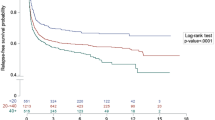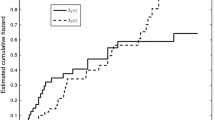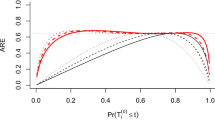Abstract
Order-restricted inference has been applied to survival analysis when its hazard function is known to have a specific shape prior to data analysis. Under the proportional hazards assumption, the partial likelihood approach is commonly used to estimate a covariate effect on the distribution of survival time without specifying its baseline hazard function, but at the same time, the shape information of the baseline hazard function cannot be used in the partial liklelihood estimation procedure. In this paper, we propose a nonparametric full likelihood method for estimating the covariate effect and baseline hazard functions simultaneously under monotone shape restriction. We develop an efficient algorithm using generalized isotonic regression techniques. We extend the algorithm to model with time-dependent covariates. Simulation studies demonstrate that the proposed full likelihood method shows smaller variance than the partial likelihood approach with reduction of bias. Analysis of data from a bone marrow transplantation study illustrates the practical utility of the isotonic methodology in estimating a nonlinear and monotone hazard function.

Similar content being viewed by others
References
Rao BP (1970) Estimation for distributions with monotone failure rate. Ann Math Stat 41(2):507–519
Padgett W, Wei L (1980) Maximum likelihood estimation of a distribution function with increasing failure rate based on censored observations. Biometrika 67(2):470–474
Mykytyn SW, Santner TJ (1981) Maximum likelihood estimation of the survival function based on censored data under hazard rate assumptions. Commun Stat-Theory Methods 10(14):1369–1387
Huang J, Wellner JA (1995) Estimation of a monotone density or monotone hazard under random censoring. Scand J Stat 22(1):3–33
Banerjee M (2008) Estimating monotone, unimodal and u-shaped failure rates using asymptotic pivots. Stat Sin 18(2):467–492
Cox DR (1972) Regression models and life-tables (with discussion). J R Stat Soc Ser B 34(2):187–220
Chung Y, Ivanova A, Hudgens MG, Fine JP (2018) Partial likelihood estimation of isotonic proportional hazards models. Biometrika 105(1):133–148
Tibshirani R, Hastie T (1987) Local likelihood estimation. J Am Stat Assoc 82(398):559–567
Staniswalis JG (1989) The kernel estimate of a regression function in likelihood-based models. J Am Stat Assoc 84(405):276–283
O’Sullivan F (1993) Nonparametric estimation in the cox model. Ann Stat 21(1):124–145
Ahn H, Loh W-Y (1994) Tree-structured proportional hazards regression modeling. Biometrics 50(2):471–485
Huang J (1999) Efficient estimation of the partly linear additive cox model. Ann Stat 27(5):1536–1563
Huang JZ, Liu L (2006) Polynomial spline estimation and inference of proportional hazards regression models with flexible relative risk form. Biometrics 62(3):793–802
Qin J, Deng G, Ning J, Yuan A, Shen Y (2021) Estrogen receptor expression on breast cancer patients’ survival under shape-restricted cox regression model. Ann Appl Stat 15(3):1291–1307
Chung D, Chang MN (1994) An isotonic estimator of the baseline hazard function in Cox’s regression model under order restriction. Stat Probab Lett 21(3):223–228
Lopuhaä HP, Nane GF (2013) Shape constrained non-parametric estimators of the baseline distribution in cox proportional hazards model. Scand J Stat 40(3):619–646
Breslow NE (1972) Discussion of Professor Cox’s paper. J R Stat Soc Ser B 34(2):216–217
Robertson T, Wright F, Dykstra RL (1988) Order restricted statistical inference. Wiley, Chichester
Ayer M, Brunk H, Ewing GM, Reid W, Silverman E (1955) An empirical distribution function for sampling with incomplete information. Ann Math Stat 26:641–647
Groeneboom P, Jongbloed G et al (2013) Smooth and non-smooth estimates of a monotone hazard. From probability to statistics and back: high-dimensional models and processes-a Festschrift in Honor of Jon A. Wellner. Institute of Mathematical Statistics, Ohio, pp 174–196
Ren J-J, Zhou M (2011) Full likelihood inferences in the cox model: an empirical likelihood approach. Ann Inst Stat Math 63(5):1005–1018
Shea TC, Walko C, Chung Y, Ivanova A, Sheets J, Rao K, Gabriel D, Comeau T, Wood W, Coghill J et al (2015) Phase I/II trial of dose-escalated busulfan delivered by prolonged continuous infusion in allogeneic transplant patients. Biol Blood Marrow Transpl 21(12):2129–2135
Grambsch PM, Therneau TM (1994) Proportional hazards tests and diagnostics based on weighted residuals. Biometrika 81(3):515–526
Singh B, Wright F (1996) Testing order restricted hypotheses with proportional hazards. Lifetime Data Anal 2(4):363–389
Sen B, Banerjee M, Woodroofe M (2010) Inconsistency of bootstrap: the grenander estimator. Ann Stat 38(4):1953–1977
Acknowledgements
The author would like to thank the associate editor and reviewers for their invaluable suggestions and comments.
Author information
Authors and Affiliations
Corresponding author
Ethics declarations
Conflict of interest
The author declared no potential conflicts of interest with respect to the research, authorship, and/or publication of this article
Appendices
Appendix 1: Proof
Proof Proposition 1
Under censored data with a time-independent covariate (4) are re-formulated to
where the parameters for uncensored subjects are included in the all three terms, while the parameters for censored subjects are included only in the last term. Thus, (12) is minimized when the parameters for censored subjects are minimized, which occur among the parameters for uncensored subjects by the order restriction. If there exists an a or b such that \(X_{a}<X^*_{(1)}\) or \(Z_{b}<Z^*_{(1)}\), (12) is minimized when \(\lambda _{a}=0\) or \(\psi _{b}=-\infty\), respectively. It shows that (12) is reduced to (9), and the isotonic estimators have jumps only at \(X^\star _{(i)}\) and \(Z^\star _{[j]}\) for \(i=1,\ldots ,n^\star\) and \(j=1,\ldots ,n^\star\). □
Proof of Proposition 2
Under censored data with a time-dependent covariate, a negative log likelihood of (10) is formulated to
where the parameters at \(X^\star _s\) and \(Z^*_t\), \(s=1,\ldots ,n^\star\) and \(t=1,\ldots ,n^\star\), are included in all three terms, while the other parameters are included only in the last term. Thus, (13) is minimized when the other parameters are maximized, which occur among the parameters in the first two terms by the order restriction. If there exists an a such that \(X_{a}<X^*_{1}\), (12) is minimized when \(\lambda (X_{a})=0\). If there exist b and c such that \(Z_b(X_{bc})<Z^*_{(1)}\), (12) is minimized when \(\psi (Z_b(X_{bc}))=-\infty\). It shows that (12) is reduced to (11), and the isotonic estimators have jumps only at \(X^\star _{(i)}\) and \(Z^*_{[j]}\) for \(i=1,\ldots ,n^\star\) and \(j=1,\ldots ,n^\star\). □
Appendix 2: R package isoSurv
In the R package isoSurv, the function named disoph is the main function that includes the methods developed. Here, we explain the usage of the disoph function using a hypothetical example below:
> test1=data.frame(
> time=c(2, 5, 1, 7, 9, 5, 3, 6, 8, 9, 7, 4, 5, 2, 8),
> status=c(0, 1, 0, 1, 0, 1, 1, 1, 1, 1, 1, 1, 1, 0, 1),
> z=c(2, 1, 1, 3, 5, 6, 7, 9, 3, 0, 2, 7, 3, 9, 4))
The test1 dataset includes 11 observations with their right-censored time, event status, and covariate values. For the standard Cox proportional hazards model with a linear predictor, the function coxph in the R package survival can be used as
>library(survival)
>fit1=coxph(Surv(time,status)\(\sim\)z,data=test1)
>print(fit1)
Similarly, the proposed isotonic proportional hazards model with monotone increasing functions \(\phi\) and \(\lambda _0\) is fitted by using the following R code:
>library(isoSurv)
>fit2=disoph(Surv(time,status)\(\sim\)iso(z,shape=“inc”),bshape=“inc”,data=test1)
>print(fit2$iso.bh)
>print(fit2$iso.cov)
>plot(fit2)
The print and plot functions printed and visualized estimated BHR and HR, respectively. In the disoph function above, instead of shape=“inc” (or bshape=“inc”), shape=“dec” (or bshape=“inc”) can be used if \(\phi\) is monotonically decreasing in z (or \(\lambda _0\) is monotonically decreasing in t). Detailed instructions on using the isoSurv package can be found using
> help(disoph)
> example(disoph)
Rights and permissions
Springer Nature or its licensor (e.g. a society or other partner) holds exclusive rights to this article under a publishing agreement with the author(s) or other rightsholder(s); author self-archiving of the accepted manuscript version of this article is solely governed by the terms of such publishing agreement and applicable law.
About this article
Cite this article
Chung, Y. Nonparametric Estimation of Proportional Hazards with Monotone Baseline Hazard and Covariate Effect. Stat Biosci (2024). https://doi.org/10.1007/s12561-024-09420-1
Received:
Revised:
Accepted:
Published:
DOI: https://doi.org/10.1007/s12561-024-09420-1




